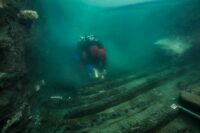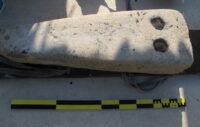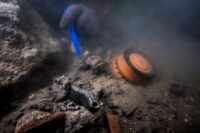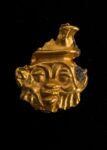 Excavation of the submerged city of Thonis-Heracleion in Aboukir Bay, 30 miles northeast of Alexandria, have revealed the remains of an ancient military vessel from the second century B.C. The ship was in the middle of being loaded with monumental stone blocks from the city’s renown Temple of Amun when it was wrecked.
Excavation of the submerged city of Thonis-Heracleion in Aboukir Bay, 30 miles northeast of Alexandria, have revealed the remains of an ancient military vessel from the second century B.C. The ship was in the middle of being loaded with monumental stone blocks from the city’s renown Temple of Amun when it was wrecked.
 The ship was more than 80 feet long with a flat bottom and flat keel, necessary features to navigate in and out of the silty ports and channels of the Nile Delta. It also carried a large sail, as we know from the large surviving mast step. The hull was built in the classical Greek style with mortise-and-tenon joints and robust internal ribbing, but using traditional Egyptian shipbuilding techniques and recycling locally-sourced wood.
The ship was more than 80 feet long with a flat bottom and flat keel, necessary features to navigate in and out of the silty ports and channels of the Nile Delta. It also carried a large sail, as we know from the large surviving mast step. The hull was built in the classical Greek style with mortise-and-tenon joints and robust internal ribbing, but using traditional Egyptian shipbuilding techniques and recycling locally-sourced wood.
The ship was moored at a landing stage in the canal that flowed along the south face of the temple when the disaster occurred. The fallen blocks have maintained the precious naval remains nailed down to the bottom of the deep canal, which is now filled with the debris of the sanctuary.
Ayman Ashmawy, Head of the Egyptian Antiquities Sector at the Ministry of Tourism and Antiquities, also said that the ship was detected under nearly five meters of hard clay mingled with remains of the temple. Its discovery comes thanks to cutting-edge prototype sub-bottom profiler electronic equipment.
 The Egyptian city of Thonis was first built in Pharaonic Egypt on what were then islands on the mouth of the Canopic Nile where it empties into the Mediterranean Sea. Herodotus recounts a legend that it was founded by Thonis, warden of the mouth of the Nile, who arrested Paris for abducting Helen of Troy. By the Late Period (664-332 B.C.), Thonis was Egypt’s primary port for international trade and would remain so until it was superseded by Alexandria under the Ptolemies in the 2nd century B.C.
The Egyptian city of Thonis was first built in Pharaonic Egypt on what were then islands on the mouth of the Canopic Nile where it empties into the Mediterranean Sea. Herodotus recounts a legend that it was founded by Thonis, warden of the mouth of the Nile, who arrested Paris for abducting Helen of Troy. By the Late Period (664-332 B.C.), Thonis was Egypt’s primary port for international trade and would remain so until it was superseded by Alexandria under the Ptolemies in the 2nd century B.C.
 The city was destroyed by natural disasters — an earthquake followed by tsunamis — in the eighth century A.D. Its ruins were rediscovered in 2000 by Franck Goddio and a team from the European Institute for Underwater Archaeology (IEASM). The remains span 40 square miles so it is still being surveyed with no more than 2% of the site excavated in small, targeted investigations. Since 2000, more than 70 ships from the 8th to the 2nd century B.C. have been discovered there, including an exceptionally intact baris, an Egyptian trading vessel described (accurately, to everyone’s surprise) by Herodotus.
The city was destroyed by natural disasters — an earthquake followed by tsunamis — in the eighth century A.D. Its ruins were rediscovered in 2000 by Franck Goddio and a team from the European Institute for Underwater Archaeology (IEASM). The remains span 40 square miles so it is still being surveyed with no more than 2% of the site excavated in small, targeted investigations. Since 2000, more than 70 ships from the 8th to the 2nd century B.C. have been discovered there, including an exceptionally intact baris, an Egyptian trading vessel described (accurately, to everyone’s surprise) by Herodotus.